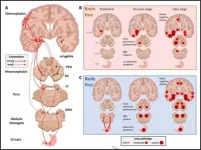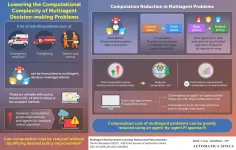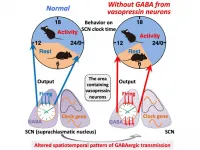Job changes following breast cancer are frequent in some cases
Study by the University of Bonn: Around ten percent of patients mention involuntary job changes
2021-04-28
(Press-News.org) Breast cancer diagnosis: Around 88 percent of patients survive the dangerous disease in the first five years. Work is important for getting back to normality. Researchers from the University of Bonn and the German Cancer Society investigated how satisfied former patients are with their occupational development over a period of five to six years since diagnosis. About half experienced at least one job change during the study period. Around ten percent of those affected even report involuntary changes. The researchers conclude that there is a need for long-term support measures for patients. The study is now published in the Journal of Cancer Survivorship.
Breast cancer is the most commonly occurring cancer in women. Almost 70,000 cases are diagnosed every year in Germany alone. Studies show that the five-year survival rate is 88 percent. "Returning to work is important; it provides a sense of normality and meaning after a crisis caused by cancer," explains sociologist Kati Hiltrop from the Center for Health Communication and Health Services Research at University Hospital Bonn (UKB). But a breast cancer diagnosis and successful treatment are often followed by long-term difficulties such as fatigue syndrome, which means a feeling of persistent tiredness, exhaustion and listlessness. Other after-effects of chemotherapy and the fear that the cancer will return can also limit productivity.
How do breast cancer patients succeed in returning to work? "There are numerous studies on this. Our long-term study now focuses on the post-return phase from the patient's perspective," says Hiltrop. Together with the head of the research center, Prof. Dr. Nicole Ernstmann, who is also a member of the Transdisciplinary Research Area "Life and Health" at the University of Bonn, and the German Cancer Society, the sociologist investigated how a total of 184 former breast cancer patients fared after returning to work over a period of five to six years after diagnosis.
From the perspective of breast cancer patients
The study focused on how satisfied the patients were with their occupational development since diagnosis. About half experienced at least one job change during the study period. "The main finding is that we found no relationship between the number of job changes and satisfaction, but that greater involuntariness of change was associated with lower satisfaction," Hiltrop says. "The results suggest that the quality of change matters more than the quantity." About 16 percent of job changes did not happen by choice. These changes included, for example, increased workload or retirement. The results suggest that the former breast cancer patients have difficulties in meeting the job requirements in the long term after their return, resulting in changes at work.
The research team's findings show what can contribute to satisfaction at work. "Providing a welcoming work environment and showing patients understanding and support can facilitate a satisfactory return to work," Hiltrop explains. This can help avoid involuntary job changes that are perceived as particularly drastic. The researchers conclude from the results that a satisfactory return to work and, in particular, remaining at work requires long-term support, for example because chemotherapies and aftercare have to be continued, there is a fear of a recurrence of the tumor, or fatigue symptoms have to be managed.
The current study is a follow-up study of the project "Strengthening patient competence: Breast cancer patients' information and training needs" (PIAT), which surveyed approximately 1000 breast cancer patients. The researchers interviewed the PIAT participants again 5-6 years after diagnosis. At four measurement points, surveys and interviews were used to explore the subjective assessment of health status, how often job changes occurred, and how fulfilling the job was. Socioeconomic data, such as age, number of children, and education, were also surveyed. Satisfaction with occupational development was associated with higher age, better perceived health status, and lower levels of involuntariness of job changes.
"Open communication with managers and colleagues about expectations and what can be accomplished is very important," explains Hiltrop. In addition, handling the situation more flexibly, can increase the likelihood that patients will be satisfied when they return to work.
INFORMATION:
Financial support and participating institutions
The study involved the University Hospital Bonn, the German Cancer Society, the Federal Centre for Health Education, the Institute of Medical Sociology, Health Services Research, and Rehabilitation Science at the University of Cologne, and the Carl von Ossietzky University of Oldenburg. The German Statutory Pension Insurance Scheme and the Federal Ministry of Health funded the projects.
Publication: Kati Hiltrop, Paula Heidkamp, Clara Breidenbach, Christoph Kowalski, Anna Enders, Holger Pfaff, Lena Ansmann, Franziska Geiser and Nicole Ernstmann: Involuntariness of job changes is related to less satisfaction with occupational development in long-term breast cancer survivors, Journal of Cancer Survivorship, DOI: http://dx.doi.org/10.1007/s11764-021-01035-5
Contact:
Kati Hiltrop
Forschungsstelle für Gesundheitskommunikation und Versorgungsforschung
Klinik und Poliklinik für Psychosomatische Medizin und Psychotherapie
Universitätsklinikum Bonn
Tel. +49-228-28711803
E-Mail: Kati.Hiltrop@ukbonn.de
ELSE PRESS RELEASES FROM THIS DATE:
2021-04-28
Amsterdam, April 28, 2021 - Parkinson's disease (PD) is characterized by slowness of movement and tremors, which often appear asymmetrically in patients. The new model of PD described in this review article published in the Journal of Parkinson's Disease may explain these perplexing asymmetrical motor symptoms and other known variations such as different degrees of constipation and sleep disorders.
PD is a heterogenous disorder. Symptoms and the speed with which symptoms progress vary greatly among patients. In three-quarters of patients, motor symptoms initially appear in one side of the body. Some ...
2021-04-28
In an interdisciplinary research project carried out at Tel Aviv University, researchers from the School of Plant Sciences affiliated with the George S. Wise Faculty of Life Sciences collaborated with their colleagues from the Sackler Faculty of Medicine in order to study the course of plant root growth. The plant researchers were aided by a computational model constructed by cancer researchers studying cancer cells, which they adapted for use with plant root cells.
The fascinating and groundbreaking findings: For the first time in the world, it has been demonstrated, at the resolution of a single cell, that the root grows ...
2021-04-28
In the quantum realm, electrons can group together to behave in interesting ways. Magnetism is one of these behaviors that we see in our day-to-day life, as is the rarer phenomena of superconductivity. Intriguingly, these two behaviors are often antagonists, meaning that the existence of one of them often destroys the other. However, if these two opposite quantum states are forced to coexist artificially, an elusive state called a topological superconductor appears, which is exciting for researchers trying to make topological qubits.
Topological qubits are exciting as one of the potential technologies for future quantum computers. In particular, topological qubits provide the basis for topological quantum ...
2021-04-28
Even though more and more vaccines against the coronavirus are being administered all over the world, many countries are still battling with outbreaks and face difficulties providing help to those in need.
One of those countries is Brazil. Here, they are facing a massive second wave outbreak, many daily deaths and instances of the health care systems collapsing. In the city of Manaus things have looked exceptionally bleak from December and through to the early spring.
The city was hit so hard by the first wave in 2020 that it was actually thought to be one of the few places in the world to have reached herd immunity. An estimated 75 percent of the population in the city had been infected. But then the second wave ...
2021-04-28
The research team led by Prof. WENG Jianping from University of Science and Technology of China (USTC) of the Chinese Academy of Sciences has implemented a comprehensive preconception-to-pregnancy management plan, namely CARNATION study, for women with type1 diabetes (T1D), to reduce the risks of adverse pregnancy outcomes and improve the pregnancy care since 2015. The study was published in Diabetes Care.
The management plan, approved by the National Health and Family Planning Commission of the People's Republic of China, is made up of the checklist for the relevant health care providers (HCPs) covering 20 items of care in different ...
2021-04-28
Computer scientists often encounter problems relevant to real-life scenarios. For instance, "multiagent problems," a category characterized by multi-stage decision-making by multiple decision makers or "agents," has relevant applications in search-and-rescue missions, firefighting, and emergency response.
Multiagent problems are often solved using a machine learning technique known as "reinforcement learning" (RL), which concerns itself with how intelligent agents make decisions in an environment unfamiliar to them. An approach usually adopted in such an endeavor is policy iteration (PI), which starts off with a "base policy" and then improves on it to generate a "rollout policy" (with the process of generation ...
2021-04-28
CHAMPAIGN, Ill. -- For more than a decade, ecologists have been warning of a downward trend in bumble bee populations across North America, with habitat destruction a primary culprit in those losses. While efforts to preserve wild bees in the Midwest often focus on restoring native flowers to prairies, a new Illinois-based study finds evidence of a steady decline in the availability of springtime flowers in wooded landscapes.
The scarcity of early season flowers in forests - a primary food source for bumble bees at this time of year - likely endangers ...
2021-04-28
WASHINGTON - The Society for Cardiovascular Angiography and Interventions (SCAI) has released an expert consensus statement providing cardiologists, cath lab directors, and hospital leadership guidance for contemporary cath lab standards. The document, "SCAI Expert Consensus Update on Best Practices in the Cardiac Catheterization Laboratory" will be presented today at the SCAI 2021 Virtual Scientific Sessions with simultaneous publication in Catheterization & Cardiovascular Interventions. The statement has been endorsed by the American College of Cardiology Clinical Policy Approval Committee, American Heart Association, ...
2021-04-28
Cells breathe, to an extent, exchanging gases, taking in energy sources from the environment and processing it. Now, researchers from Tohoku University in Japan have shone a light on the process in a new way.
Their demonstrated visualization method in model systems was made available online on March 12th in Biosensors and Bioelectronics, ahead of the June print edition.
The researchers used spheroids - cultured cells within a close-to-natural environment - to mimic a biological tissue using mesenchymal stem cells (MSCs). Due to MCSs' ability to self-renew and differentiate into various ...
2021-04-28
Our bodies and behaviors often seem to have rhythms of their own. Why do we go to the bathroom at the same time every day? Why do we feel off if we can't go to sleep at the right time? Circadian rhythms are a behind-the-scenes force that shape many of our behaviors and our health. Michihiro Mieda and his team at Kanazawa University in Japan are researching how the brain's circadian rhythm control center regulates behavior.
Termed the superchiasmatic nucleus, or SCN, the control center contains many types of neurons that transmit signals using the molecule GABA, but little is known about how each type contributes to our bodily rhythms. In their newest study, the researchers focused on GABA neurons that produce arginine vasopressin, a hormone that regulates ...
LAST 30 PRESS RELEASES:
[Press-News.org] Job changes following breast cancer are frequent in some cases
Study by the University of Bonn: Around ten percent of patients mention involuntary job changes





